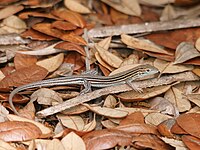
Photo from wikipedia
Although disturbance theory has been recognized as a useful framework in examining the stability of ant-plant mutualisms, very few studies have examined the effects of fire disturbance on these mutualisms.… Click to show full abstract
Although disturbance theory has been recognized as a useful framework in examining the stability of ant-plant mutualisms, very few studies have examined the effects of fire disturbance on these mutualisms. In myrmecophyte-dominated savannas, fire and herbivory are key drivers that could influence ant-plant mutualisms by causing complete colony mortality and/or decreasing colony size, which potentially could alter dominance hierarchies if subordinate species are more fire resilient. We used a large-scale, replicated fire experiment to examine long-term effects of fire on acacia-ant community composition. To determine if fire shifted ant occupancy from a competitive dominant to a subordinate ant species, we surveyed the acacia-ant community in 6-7 yr old burn sites and examined how the spatial scale of these burns influenced ant community responses. We then used two short-term fire experiments to explore possible mechanisms for the shifts in community patterns observed. Because survival of ant colonies is largely dependent on their ability to detect and escape an approaching fire, we first tested the evacuation response of all four ant species when exposed to smoke (fire signal). Then to better understand how fire and its interaction with large mammal herbivory affect the density of ants per tree, we quantified ant worker density in small prescribed burns within herbivore exclusion plots. We found clear evidence suggesting that fire disturbance favored the subordinate ant Crematogaster nigriceps more than the dominant and strong mutualist ant C. mimosae, whereby C. nigriceps (1) was the only species to occupy a greater proportion of trees in 6-7 yr old burn sites compared to unburned sites, (2) had higher burn/unburn tree ratios with increasing burn size, and (3) evacuated significantly faster than C. mimosae in the presence of smoke. Fire and herbivory had opposite effects on ant density per meter of branch for both C. nigriceps and C. mimosae, with fire decreasing ant densities per meter of branch and the presence of large herbivores increasing ant density. Taken together, these experiments suggest that major ecosystem disturbances like fire can disrupt mutualistic associations and maintain diversity in partner quality and identity despite a clear dominance hierarchy.
Journal Title: Ecology
Year Published: 2017
Link to full text (if available)
Share on Social Media: Sign Up to like & get
recommendations!